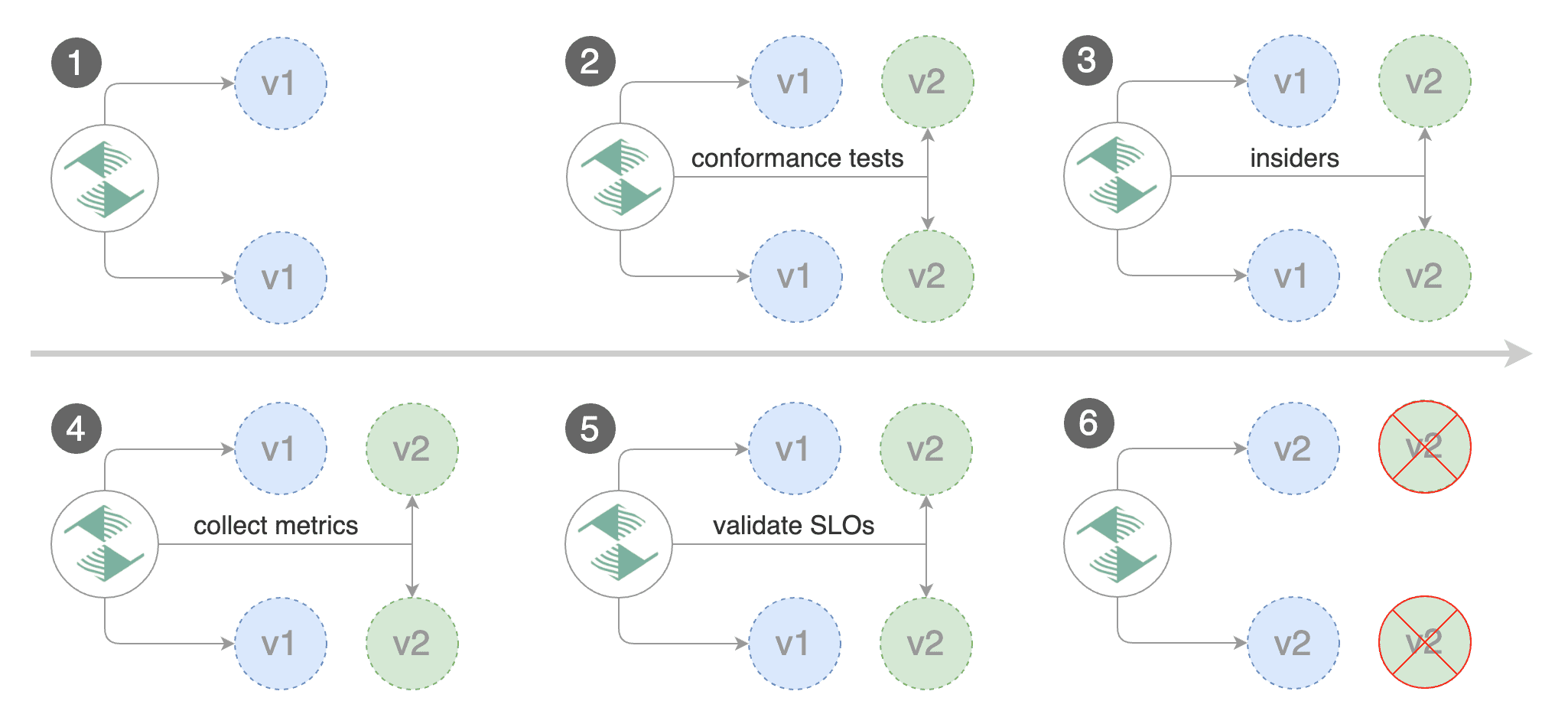You are viewing documentation for Flux version: 2.2
Version 2.2 of the documentation is no longer actively maintained. The site that you are currently viewing is an archived snapshot. For up-to-date documentation, see the latest version.
Istio A/B Testing
This guide shows you how to automate A/B testing with Istio and Flagger.
Besides weighted routing, Flagger can be configured to route traffic to the canary based on HTTP match conditions. In an A/B testing scenario, you’ll be using HTTP headers or cookies to target a certain segment of your users. This is particularly useful for frontend applications that require session affinity.

Prerequisites
Flagger requires a Kubernetes cluster v1.16 or newer and Istio v1.0 or newer.
Install Istio with telemetry support and Prometheus:
istioctl manifest install --set profile=default
kubectl apply -f https://raw.githubusercontent.com/istio/istio/release-1.8/samples/addons/prometheus.yaml
Install Flagger in the istio-system namespace:
kubectl apply -k github.com/fluxcd/flagger//kustomize/istio
Create an ingress gateway to expose the demo app outside of the mesh:
apiVersion: networking.istio.io/v1alpha3
kind: Gateway
metadata:
name: public-gateway
namespace: istio-system
spec:
selector:
istio: ingressgateway
servers:
- port:
number: 80
name: http
protocol: HTTP
hosts:
- "*"
Bootstrap
Create a test namespace with Istio sidecar injection enabled:
kubectl create ns test
kubectl label namespace test istio-injection=enabled
Create a deployment and a horizontal pod autoscaler:
kubectl apply -k https://github.com/fluxcd/flagger//kustomize/podinfo?ref=main
Deploy the load testing service to generate traffic during the canary analysis:
kubectl apply -k https://github.com/fluxcd/flagger//kustomize/tester?ref=main
Create a canary custom resource (replace example.com with your own domain):
apiVersion: flagger.app/v1beta1
kind: Canary
metadata:
name: podinfo
namespace: test
spec:
# deployment reference
targetRef:
apiVersion: apps/v1
kind: Deployment
name: podinfo
# the maximum time in seconds for the canary deployment
# to make progress before it is rollback (default 600s)
progressDeadlineSeconds: 60
# HPA reference (optional)
autoscalerRef:
apiVersion: autoscaling/v2beta2
kind: HorizontalPodAutoscaler
name: podinfo
service:
# container port
port: 9898
# Istio gateways (optional)
gateways:
- public-gateway.istio-system.svc.cluster.local
# Istio virtual service host names (optional)
hosts:
- app.example.com
# Istio traffic policy (optional)
trafficPolicy:
tls:
# use ISTIO_MUTUAL when mTLS is enabled
mode: DISABLE
analysis:
# schedule interval (default 60s)
interval: 1m
# total number of iterations
iterations: 10
# max number of failed iterations before rollback
threshold: 2
# canary match condition
match:
- headers:
user-agent:
regex: ".*Firefox.*"
- headers:
cookie:
regex: "^(.*?;)?(type=insider)(;.*)?$"
metrics:
- name: request-success-rate
# minimum req success rate (non 5xx responses)
# percentage (0-100)
thresholdRange:
min: 99
interval: 1m
- name: request-duration
# maximum req duration P99
# milliseconds
thresholdRange:
max: 500
interval: 30s
# generate traffic during analysis
webhooks:
- name: load-test
url: http://flagger-loadtester.test/
timeout: 15s
metadata:
cmd: "hey -z 1m -q 10 -c 2 -H 'Cookie: type=insider' http://podinfo.test:9898/"
Note that when using Istio 1.5 you have to replace the request-duration with a
metric template.
The above configuration will run an analysis for ten minutes targeting Firefox users and those that have an insider cookie.
Save the above resource as podinfo-abtest.yaml and then apply it:
kubectl apply -f ./podinfo-abtest.yaml
After a couple of seconds Flagger will create the canary objects:
# applied
deployment.apps/podinfo
horizontalpodautoscaler.autoscaling/podinfo
canary.flagger.app/podinfo
# generated
deployment.apps/podinfo-primary
horizontalpodautoscaler.autoscaling/podinfo-primary
service/podinfo
service/podinfo-canary
service/podinfo-primary
destinationrule.networking.istio.io/podinfo-canary
destinationrule.networking.istio.io/podinfo-primary
virtualservice.networking.istio.io/podinfo
Automated canary promotion
Trigger a canary deployment by updating the container image:
kubectl -n test set image deployment/podinfo \
podinfod=ghcr.io/stefanprodan/podinfo:6.0.1
Flagger detects that the deployment revision changed and starts a new rollout:
kubectl -n test describe canary/abtest
Status:
Failed Checks: 0
Phase: Succeeded
Events:
Type Reason Age From Message
---- ------ ---- ---- -------
Normal Synced 3m flagger New revision detected podinfo.test
Normal Synced 3m flagger Scaling up podinfo.test
Warning Synced 3m flagger Waiting for podinfo.test rollout to finish: 0 of 1 updated replicas are available
Normal Synced 3m flagger Advance podinfo.test canary iteration 1/10
Normal Synced 3m flagger Advance podinfo.test canary iteration 2/10
Normal Synced 3m flagger Advance podinfo.test canary iteration 3/10
Normal Synced 2m flagger Advance podinfo.test canary iteration 4/10
Normal Synced 2m flagger Advance podinfo.test canary iteration 5/10
Normal Synced 1m flagger Advance podinfo.test canary iteration 6/10
Normal Synced 1m flagger Advance podinfo.test canary iteration 7/10
Normal Synced 55s flagger Advance podinfo.test canary iteration 8/10
Normal Synced 45s flagger Advance podinfo.test canary iteration 9/10
Normal Synced 35s flagger Advance podinfo.test canary iteration 10/10
Normal Synced 25s flagger Copying podinfo.test template spec to podinfo-primary.test
Warning Synced 15s flagger Waiting for podinfo-primary.test rollout to finish: 1 of 2 updated replicas are available
Normal Synced 5s flagger Promotion completed! Scaling down podinfo.test
Note that if you apply new changes to the deployment during the canary analysis, Flagger will restart the analysis.
You can monitor all canaries with:
watch kubectl get canaries --all-namespaces
NAMESPACE NAME STATUS WEIGHT LASTTRANSITIONTIME
test podinfo Progressing 100 2019-03-16T14:05:07Z
prod frontend Succeeded 0 2019-03-15T16:15:07Z
prod backend Failed 0 2019-03-14T17:05:07Z
Automated rollback
During the canary analysis you can generate HTTP 500 errors and high latency to test Flagger’s rollback.
Generate HTTP 500 errors:
watch curl -b 'type=insider' http://app.example.com/status/500
Generate latency:
watch curl -b 'type=insider' http://app.example.com/delay/1
When the number of failed checks reaches the canary analysis threshold, the traffic is routed back to the primary, the canary is scaled to zero and the rollout is marked as failed.
kubectl -n test describe canary/podinfo
Status:
Failed Checks: 2
Phase: Failed
Events:
Type Reason Age From Message
---- ------ ---- ---- -------
Normal Synced 3m flagger Starting canary deployment for podinfo.test
Normal Synced 3m flagger Advance podinfo.test canary iteration 1/10
Normal Synced 3m flagger Advance podinfo.test canary iteration 2/10
Normal Synced 3m flagger Advance podinfo.test canary iteration 3/10
Normal Synced 3m flagger Halt podinfo.test advancement success rate 69.17% < 99%
Normal Synced 2m flagger Halt podinfo.test advancement success rate 61.39% < 99%
Warning Synced 2m flagger Rolling back podinfo.test failed checks threshold reached 2
Warning Synced 1m flagger Canary failed! Scaling down podinfo.test
The above procedure can be extended with custom metrics checks, webhooks, manual promotion approval and Slack or MS Teams notifications.